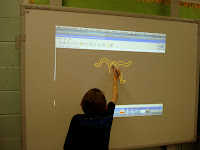
ROY LICHTENSTEIN INSPIRED LESSON WITH ADAPTIONS
Roy Lichtenstein and his colorful "Pop" artworks makes for an engaging lesson. Adding a language arts component with a lesson on onamonapias creates a great cross curricular connection. Adapting this lesson for students with cognitive and fine motor deficits was relatively easy.As I gathered students around to discuss the artist after viewing an ABC good Morning clip, the excitement over Lichtenstein's art was evident. I had the students go around in a circle and name an onamonapia after we discussed what they were. I purposely had my students with learning disabilities go towards the end so they would learn by example. It worked they picked up on those words that sound like they are written.
The objectives of the lesson were to use an onamonapia, use at least 2 illustration techniques that Lichtenstein used, such as ben-day dots, a black outline, primary colors and multiple hatching lines.
Adapting The Lesson
The lesson was adapted by having students with disabilities use pre-printed or cut stencils for the words, Giving students a choice is very important, you should never just hand them a word you chose. The lesson's objectives were reduced to only needing one illustration technique to meet the students at their level of readiness.
The lesson was adapted by having students with disabilities use pre-printed or cut stencils for the words, Giving students a choice is very important, you should never just hand them a word you chose. The lesson's objectives were reduced to only needing one illustration technique to meet the students at their level of readiness.
Offer a choice of spelling the word with pre-cut letters or printed text.

Outlining the newspaper cutout can be done hand-over-hand, independently with verbal guidance or by a paraprofessional as a way to define the area to be painted. Your choice depends on the individual skill level of the student.
 |
| Adapted Student Artwork |
 |
| Student Artwork by able-bodied peer. |






































